
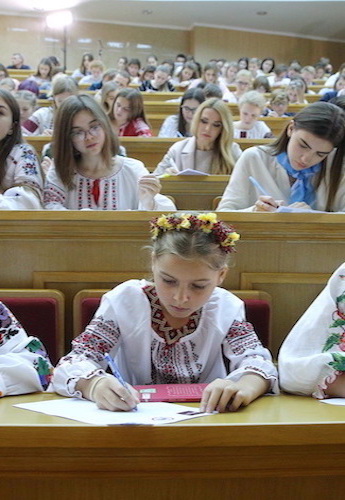
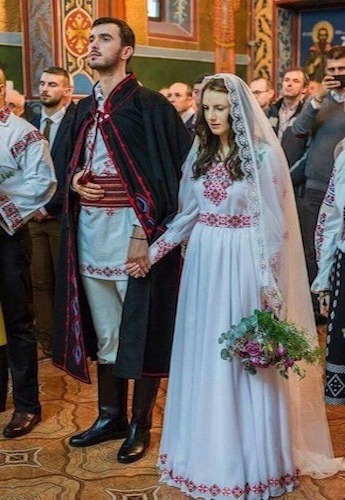
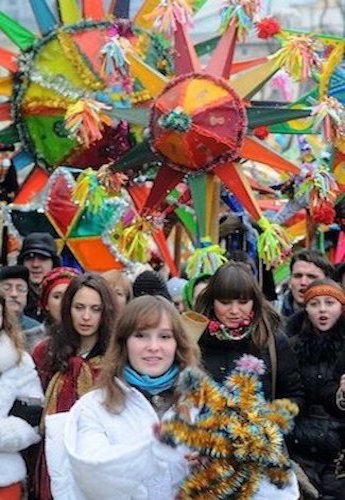
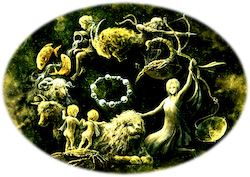
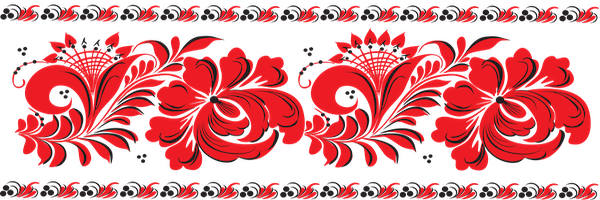
Ukrainian folklore is the folk tradition which has developed in Ukraine and among ethnic Ukrainians. The earliest examples of folklore found in Ukraine is the layer of pan-Slavic folklore that dates back to the ancient Slavic mythology of the Eastern Slavs. Gradually, Ukrainians developed a layer of their own distinct folk culture. Folklore has been an important tool in defining and retaining a cultural distinctiveness in Ukraine in the face of strong assimilatory pressures from neighboring lands.
| Folk Music | Ukrainian Literature | Ukrainian Wedding | Ukrainian Holidays |
|---|---|---|---|
 |
 |
 |
 |
| Ukrainians, particularly in the Eastern Ukraine have fostered a peculiar style of singing – The White voice. This type of singing primarily exploits the chest register and is akin to controlled yelling or shouting. The vocal range is restrictive and in a lower tessitura. In recent times vocal courses have been established to study this particular form of singing. Among the most popular exponents of traditional Ukrainian folk singing in the modern era are Nina Matviyenko and Raissa Kyrychenko. Ukrainian music covers diverse and multiple component elements of the music that is found in the Western and Eastern musical civilization. It also has a very strong indigenous Slavic and Christian uniqueness whose elements were used among many neighboring nations. Ukraine is also the rarely acknowledged musical heartland of the former Russian Empire, home to its first professional music academy, which opened in the mid-18th century and produced numerous early musicians and composers. | Ukrainian literature mostly developed under foreign domination over Ukrainian territories. At times Ukrainian language was partly outlawed in oral and print form from 17th to early 21st century. However, foreign rule by the Polish–Lithuanian Commonwealth, Poland, the Russian Empire, the Kingdom of Romania, the Austria-Hungary Empire, and the Ottoman Empire, enriched Ukrainian culture and language, and Ukrainian authors were able to produce a rich literary heritage. Ukrainian fiction is still a terra incognita for many reading people worldwide. The earliest writings of the Ukrainians, works produced in Kievan Rus from the 11th to the 13th century, were composed in Church Slavonic and are thus the common literary heritage of the Russians and Belarusians as well. After the Mongol invasion (13th century), Ukrainian literature was in decline until its revival in the 16th century. By the early 19th century the Ukrainian vernacular had become the primary vehicle of literary expression, and an era of prolific writing began. | Traditional Ukrainian wedding celebrations have many rituals that involve music and dancing, drinking and eating, and crowds of people. The wedding consists of three separate parts that can last for days or even weeks. First there's a betrothal, then a ceremony, followed by a big celebration. The betrothal involves the groom going to the bride's parents to bargain for ransom he will pay for the bride and to seek the blessing of her parents. There are many stories in Ukrainian folklore of a bride being stolen without the groom paying ransom. Often, the stolen bride is a willing participant and the couple elopes without her parents permission. Alternatively, the bride can refuse an offer of marriage, in which case, it is customary for the parents to meet the groom at the door with a pumpkin to convey the message. After they reach an agreement, the official wedding takes place in a church, often in a group ceremony with other couples. A celebration follows at home with the entire community participating. | Ukrainians love their numerous holidays and love to "celebrate" those holidays in grandeous fashion. It's not uncommon for Westerners to be taken aback at just how many "days of note" they observe, and the amount of fireworks and revelry that goes along with them. Ukraine's history that included Paganism and later Christianity can be attributed to the evolution of many of her current holidays and festivities. The history of Ukraine comes from far ancient times. There are lots of celebrations in Ukraine that symbolize beauty, heartfulness and joy of living. Saint Valentine’s Day, Maslenitsa, the holiday of winter seeing off, International Women’s Day, Easter with beautifully colored eggs, Victory Day, Holy Trinity, Constitution Day and many other holidays are celebrated every year. An important place is occupied by festivals and celebrations that embody the soul of t he people, national characteristics and traditions of Ukrainians. They diversify and enliven everyday life, providing the opportunity to relax, to get inspiration and to show the elegance of Ukrainian traditions. |

Ethnography in late-nineteenth-century Ukraine documented a "thorough synthesis of pagan and Christian elements" in Slavic folk religion, a system often called "double belief" According to Bernshtam, dvoeverie is still used to this day in scholarly works to define Slavic folk religion, which is seen by certain scholars as having preserved much of pre-Christian Slavic religion, "poorly and transparently" covered by a Christianity that may be easily "stripped away" to reveal more or less "pure" patterns of the original faith. Since the collapse of the Soviet Union there has been a new wave of scholarly debate on the subjects of Slavic folk religion. Bernshtam, a Soviet academic, challenges dualistic notions of dvoeverie and proposes to interpret broader Slavic religiosity as a mnogoverie ("multifaith") continuum, in which a higher layer of Orthodox Christian officialdom is alternated with a variety of "Old Beliefs" among the various strata of the population
| Mavka | Leshy | Rusalka | Chugaister |
|---|---|---|---|
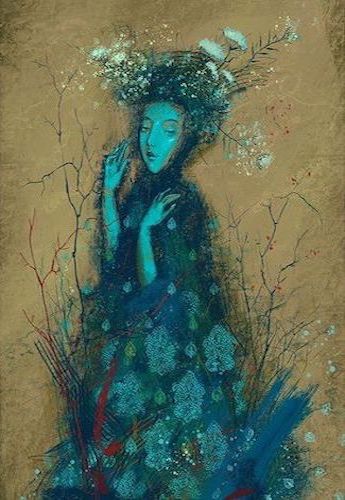 |
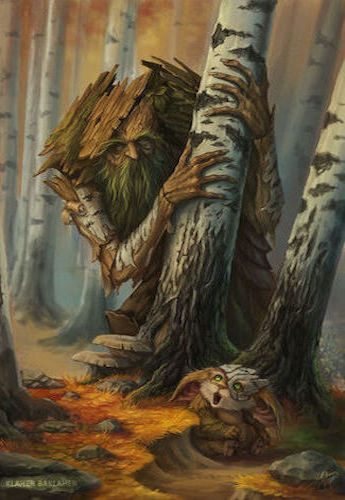 |
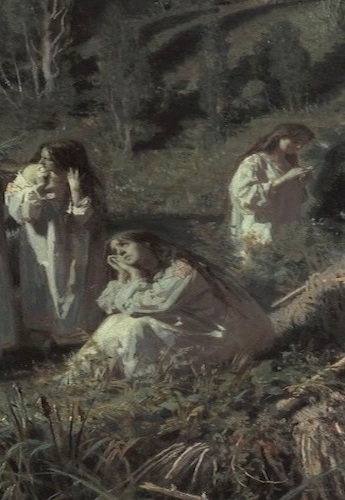 |
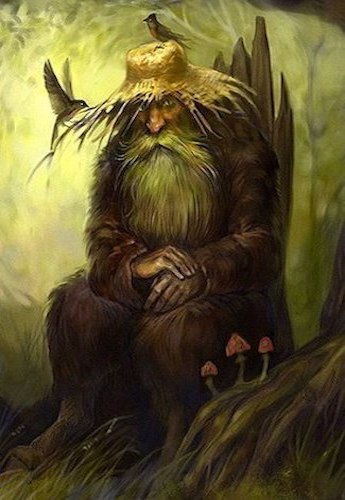 |
| Mavka is a type of female spirit in Ukrainian mythology. She is a long-haired figure, sometimes naked, who may be dangerous to young men. The spirits known by this term represented the souls of girls who had died unnatural tragic or premature deaths, particularly unchristened babies. Mavkas often appeared in the form of beautiful young girls who enticed and lured young men into the woods, where they "tickled" them to death. Mavkas had no reflection in water, did not cast shadows, and had "no back", meaning that their insides could be seen. (Those were more often called "Nyavka" and they were believed to live in Western Ukraine, which has more dangerous mountain rivers than Central Ukraine, while Mavkas, who were believed to live in Central Ukraine, had their backs. In some accounts, they were also said to help farmers by looking after cattle and driving out wild animals. | The Leshy is a tutelary deity of the forests in Slavic mythology. rules over the forest and hunting, he may be related to the Slavic god Porewit. The Leshy is masculine and humanoid in shape, is able to assume any likeness and can change in size and height. He is sometimes portrayed with horns and surrounded by packs of wolves and bears. He is known by some to have a propensity to lead travelers astray and abduct children (which he shares with Chort, the "Black One"), which would lead some to believe he is an evil entity. He is, however, also known to have a more neutral disposition towards humans, dependent on the attitudes and behaviours of an individual person, or local population, towards the forest. Leshy could take children who were cursed by their relatives (in particular, parents) away to the forest people. Some would therefore describe him as more of a temperamental being, like a fairy. | In Ukrainian folklore, the rusalka is a female entity, often malicious toward mankind and frequently associated with water. Folklorists have proposed a variety of origins for the entity, including that they may originally stem from Slavic paganism, where they may have been seen as benevolent spirits. Rusalki appear in a variety of media in modern popular culture, particularly in Slavic language-speaking countries, where they frequently resemble the concept of the mermaid. While lore often says that the rusalki could not completely stand out of water, some fiction works tell of rusalki that could climb trees and sing songs, sit on docks with only submerged feet and comb their hair, or even join other rusalki in circle dances in the field. A particular feature of such stories revolves around the fact that this behaviour would be limited to only certain periods of the year, usually the summer (see Rusalka Week section). | The Chuhaister is a Ukrainian tutelary deity of the forests. Although he shares similarities with the Russian Leshy, he is specific to the Ukrainian Carpathians. Chuhaister are masculine and humanoid in shape. They are described either as being giant, long-haired old men who roam the woods naked or in white clothes, or as one-legged men to whom no harm can be done. They are also imagined as the wind. Their temperament is described as being cheerful and they are known to love singing and dancing. Unlike the Leshy, they are not dangerous to humans.The origin of the name Chuhaister is unclear, but it may be related to the Proto-Slavic root *čuga, meaning to guard. The origin of the second part of the word is unknown although it has been linked to the word for stork. The word may be of a foreign origin. |